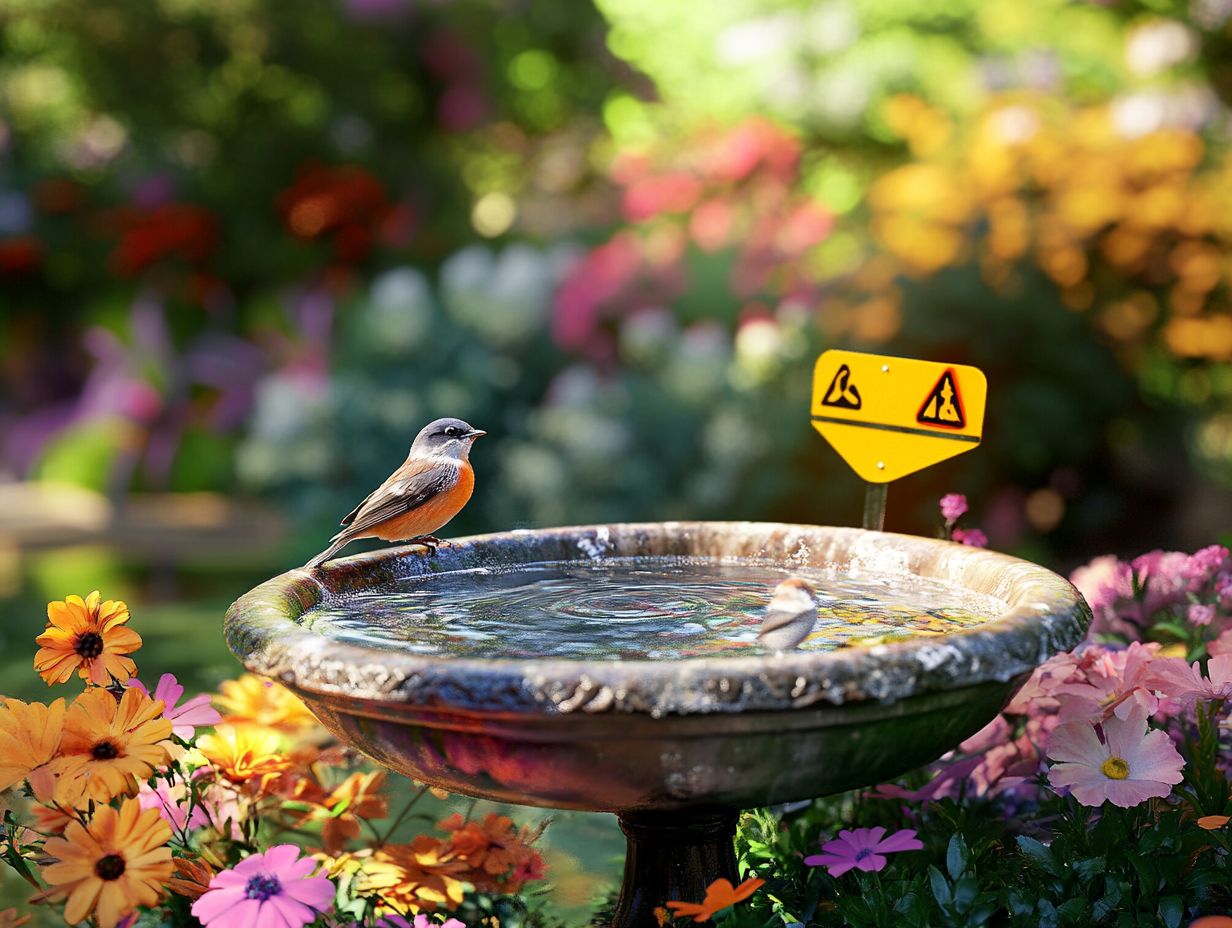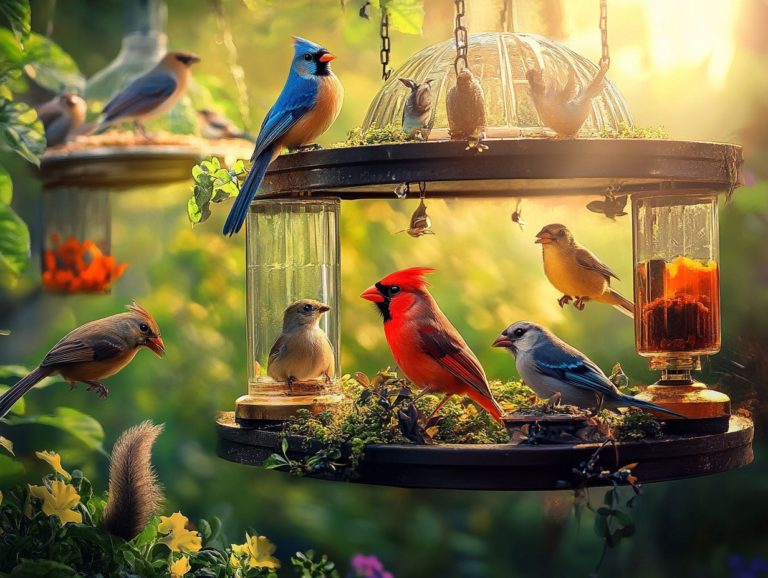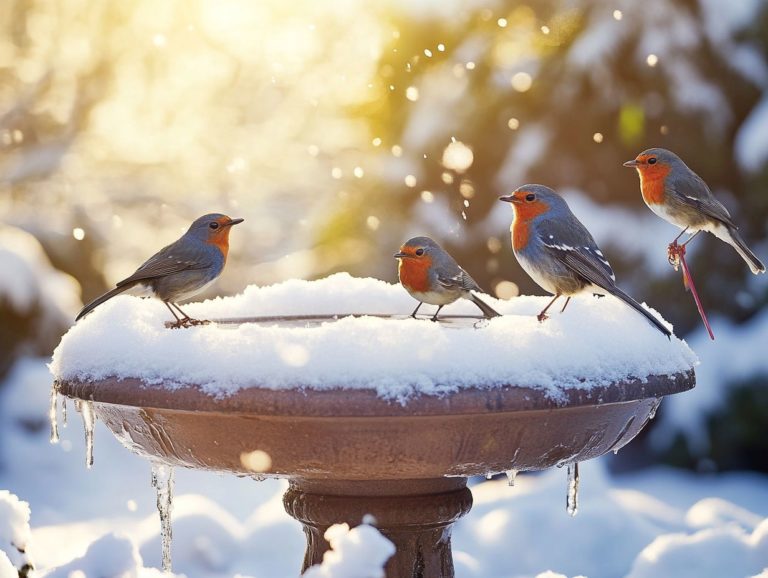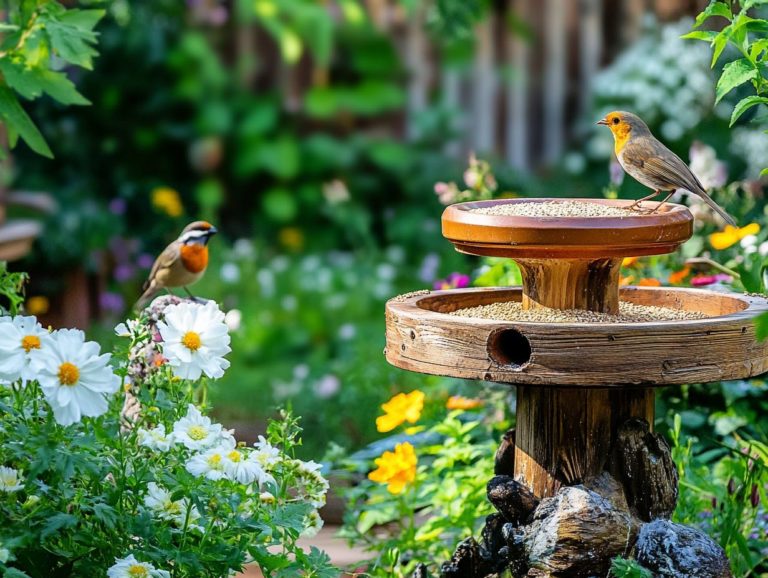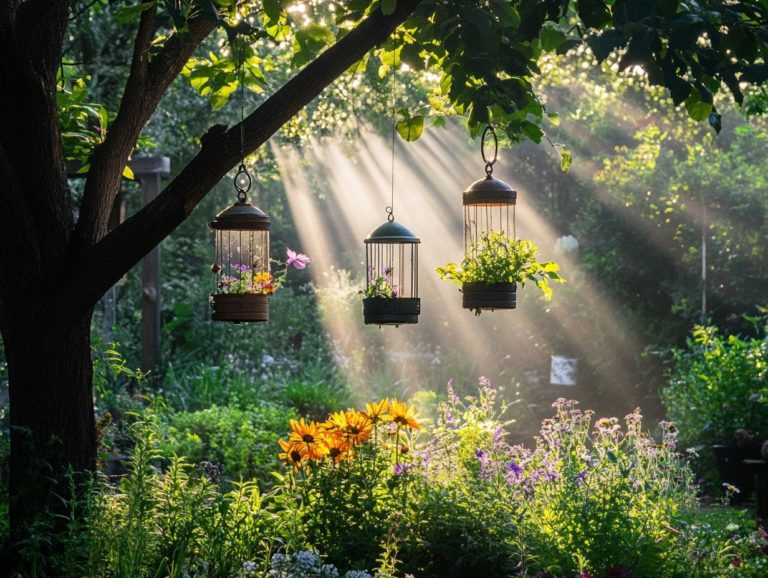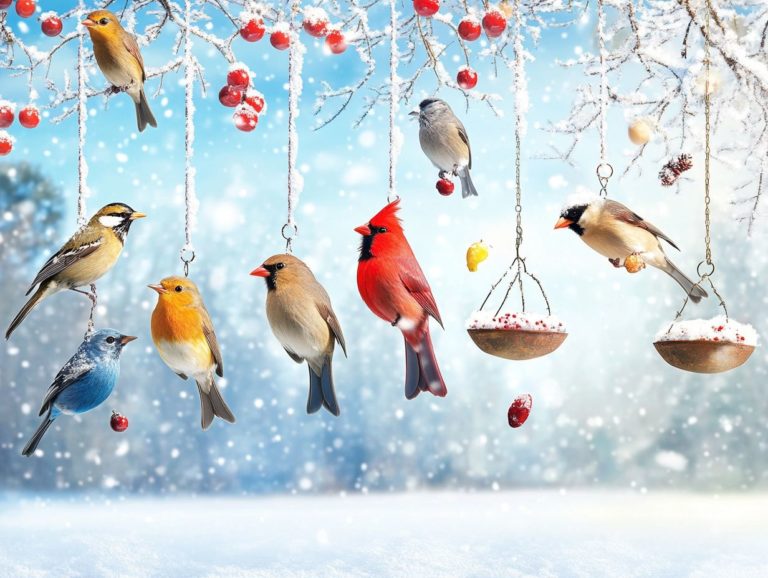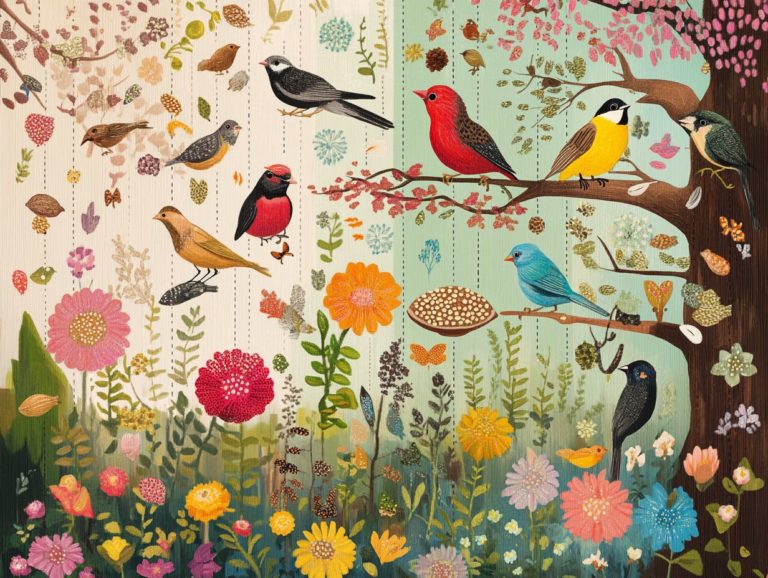Bird Bath Safety: What to Watch For
Creating a safe environment for your feathered friends is essential, especially when it comes to bird baths.
These delightful features invite birds to hydrate and enjoy a refreshing bath, but they can also pose potential hazards.
You ll discover the common dangers birds might encounter in and around bird baths, along with essential tips for selecting a safe option. We ll also cover proper maintenance practices to ensure you create a healthy oasis for them.
You will also learn how to spot signs of illness in birds using important resources. Imagine your backyard as a vibrant sanctuary for birds!
Contents
Key Takeaways:
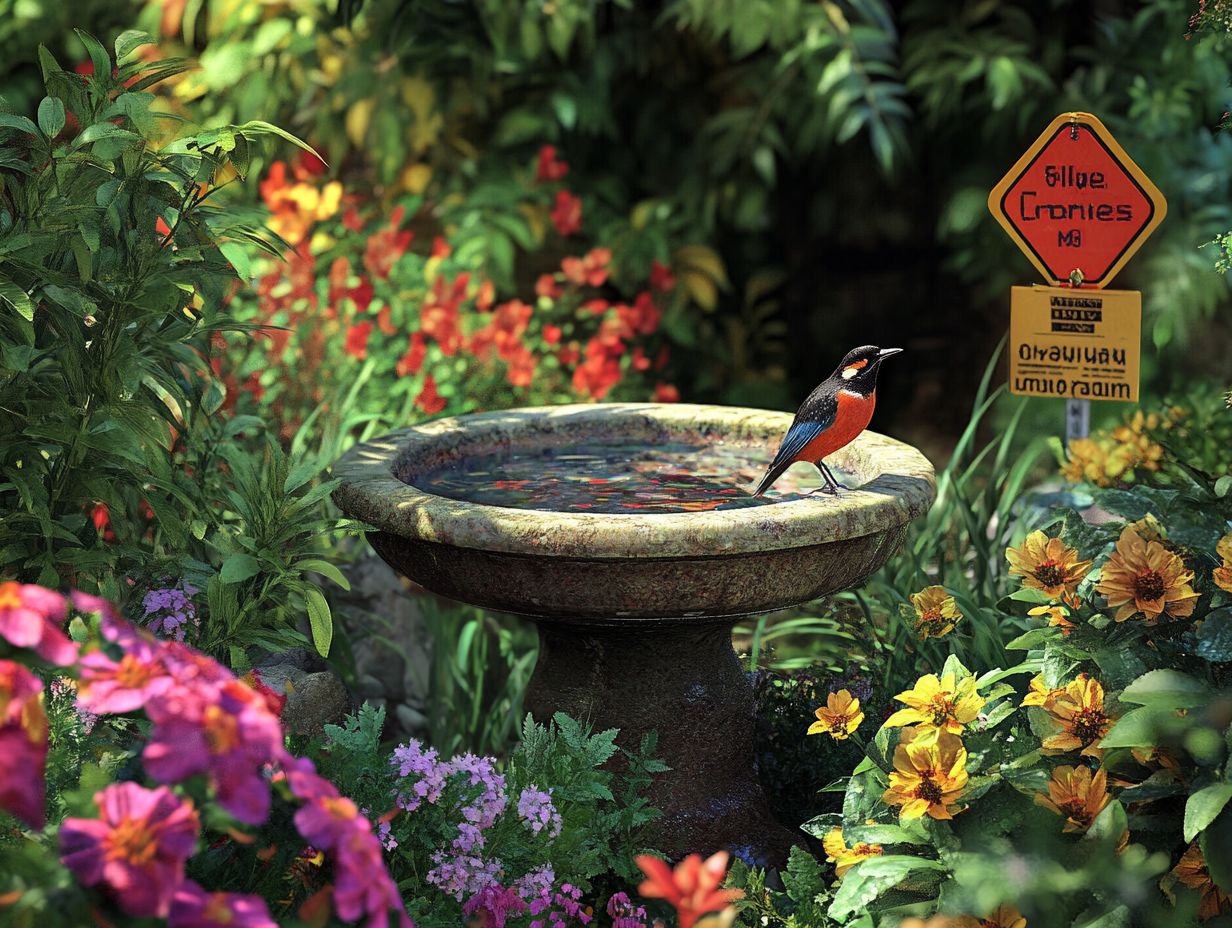
- Keep your feathered friends safe by being aware of potential hazards in bird baths such as slippery surfaces, deep water, and predators.
- Choose a bird bath that is safe and suitable for your specific bird species, considering factors like size, depth, and materials.
- Act now! Regularly cleaning your bird bath is crucial to keep your feathered friends safe from diseases. Keep an eye out for signs of illness or injury when birds visit the bath.
Why is Bird Bath Safety Important?
Ensuring bird bath safety is vital for fostering a thriving backyard wildlife habitat. Clean bird baths are essential for attracting birds. Ignoring bird bath safety can harm your visiting birds.
Key factors such as water quality, depth, and regular cleaning practices are crucial in creating a safe and inviting oasis for birds while preventing the spread of common bird diseases like Salmonellosis and Avian influenza, which can spread through dirty water.
Prioritizing these aspects will enhance the enjoyment for the birds and contribute to the overall health of your local ecosystem.
Common Hazards for Birds in Bird Baths
Common hazards for birds in bird baths often arise from design missteps, including improper sizing or the use of unsuitable materials, which can lead to health problems like Avian Pox and Aspergillosis.
It’s essential to consider factors like the depth of the bird bath and the movement of the water. These elements are crucial in preventing accidents and diseases, ensuring that your charming backyard visitors have a safe and enjoyable space to drink and bathe.
Types of Hazards and Prevention Tips
Identifying the types of hazards in your bird baths is crucial for ensuring the safety of your feathered visitors. Common mistakes, such as improper placement and inadequate cleaning, can significantly impact the overall effectiveness of your bird bath. By establishing effective prevention tips, you can create a welcoming and safe atmosphere for various bird species.
One notable hazard is stagnant water, which can breed harmful bacteria and attract unwelcome pests like mosquitoes. To mitigate these risks, regularly change the water and ensure proper drainage. Ideally, your bird bath should provide shelter from harsh winds and predators while remaining visible to the birds.
Clean the bird bath at least every few days. If you live in a colder region, consider a heated bird bath; it can be a game-changer, preventing water from freezing and ensuring your feathered friends have access year-round. Each of these considerations plays a pivotal role in fostering a healthy and vibrant bird-watching environment.
How to Choose a Safe Bird Bath
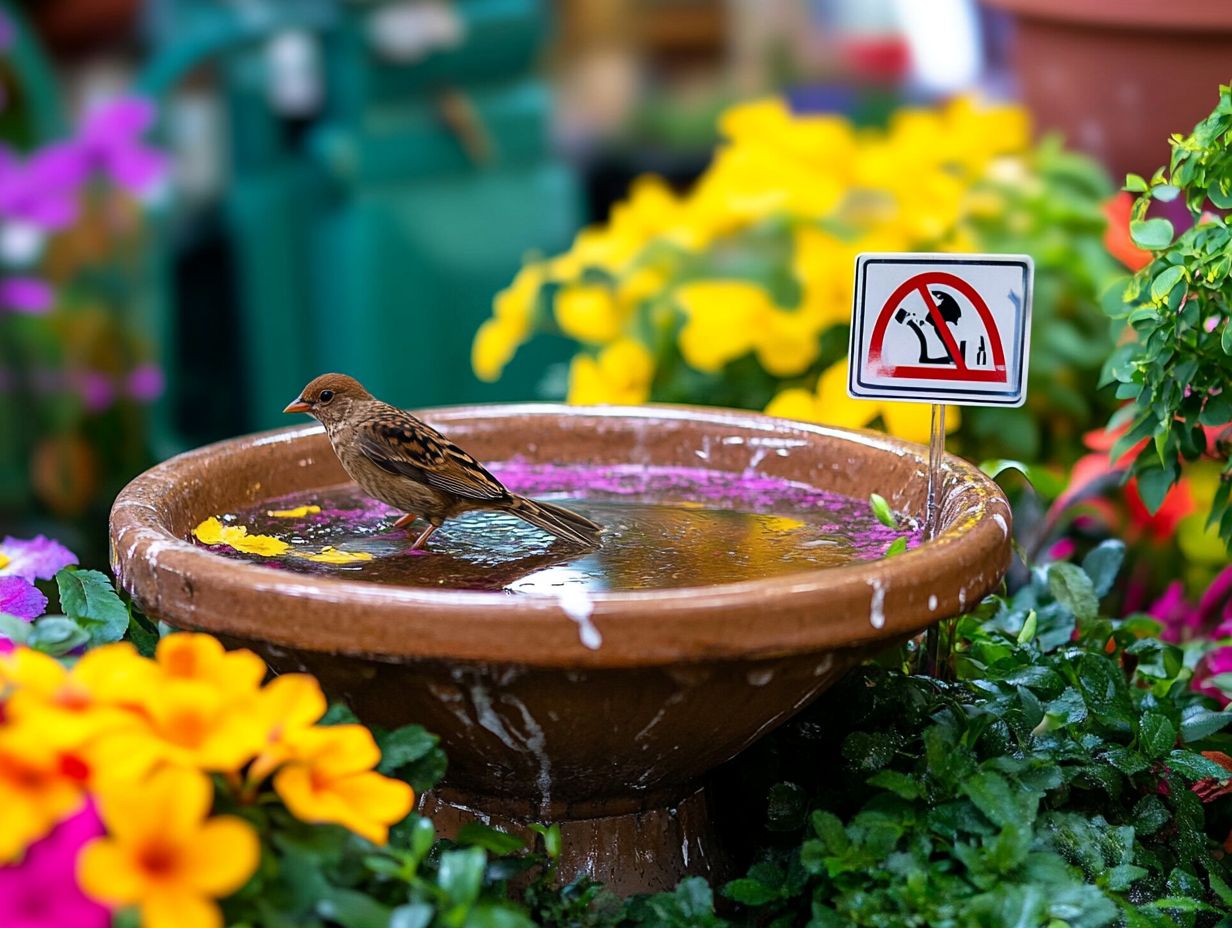
Selecting a safe bird bath demands careful attention to several key factors, such as design, depth, and the potential pitfalls of choosing the wrong size.
A well-designed bird bath should not only enhance water quality but also create a welcome environment for birds to bathe safely. This careful choice minimizes the risk of disease while accommodating the diverse preferences of various bird species.
Factors to Consider When Purchasing
When you re in the market for a bird bath, it s essential to consider various factors, such as maintenance requirements, the optimal location for your bath, and features like a heater for those chilly climates. Don t overlook the significance of water movement; it plays a crucial role in attracting birds.
Opting for a shallow design can enhance accessibility for smaller species, ensuring they have a delightful bathing experience. Placement is key find a quiet spot with nearby shelter, as this will make your bath a more inviting destination for feathered visitors.
A well-maintained bird bath not only keeps the water crystal clear, minimizing the risk of disease, but also ensures that your backyard remains a favored hangout for birds. Incorporating features like a fountain or a dripper can create gentle water movement, which is particularly alluring, as most birds have an instinctual preference for flowing water.
By thoughtfully evaluating these elements, you can create a great space that attracts a diverse array of birds, enriching your overall backyard experience.
Proper Maintenance and Cleaning of Bird Baths
Proper maintenance and cleaning of bird baths are super important to ensure they remain a safe and inviting sanctuary for birds, significantly affecting the water quality and hygiene of your fresh water bird bath.
By regularly removing debris and sanitizing the bath, you can effectively prevent the spread of diseases, all while enticing more feathered friends to visit your backyard.
Best Practices for Bird Bath Maintenance
Implementing best practices for bird bath maintenance is essential for creating an optimal bathing experience for your feathered friends. This includes:
- Ensuring the correct depth of the bath
- Selecting the right materials
- Regularly filling the bird bath with fresh water
- Using a bird bath heater during colder months to maintain water quality
A well-maintained bird bath acts not only as a refreshing oasis but also as a sanctuary for various bird species. It s crucial to inspect the water regularly for cleanliness; stagnant or dirty water can discourage birds from visiting and even lead to health problems.
When filling the bath, use gentle pouring techniques to avoid splashes that might send your avian guests fluttering away. Seasonal maintenance is just as important.
In winter, a heater can prevent the water from freezing, ensuring that your bath remains accessible even in the cold. These thoughtful practices not only enhance the well-being of your avian visitors but also attract a diverse array of species, turning your backyard into a vibrant paradise for birdwatching enthusiasts.
Signs of Illness or Injury in Birds Using Bird Baths
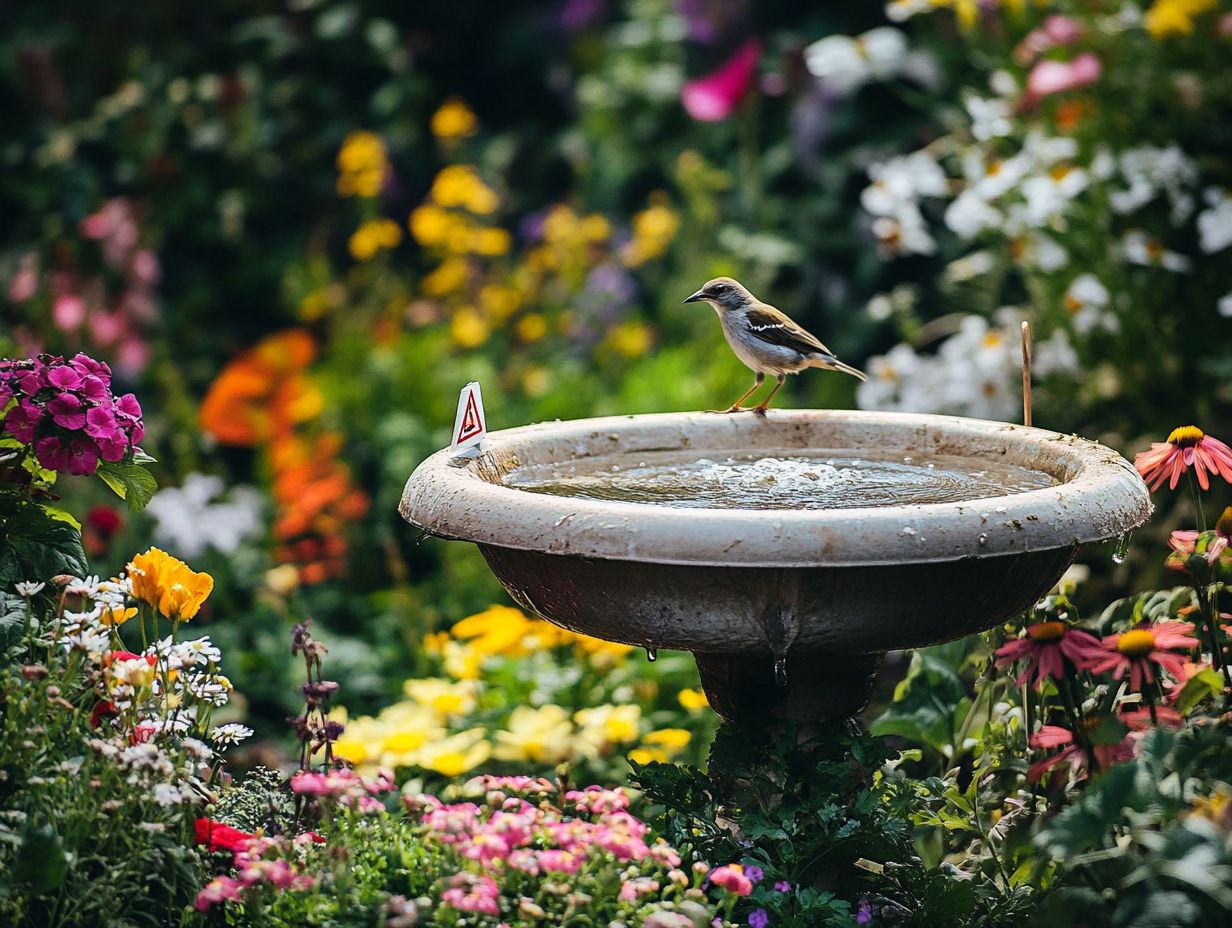
Recognizing the signs of illness or injury in birds while using bird baths is crucial for promoting their safety. Certain diseases, like avian influenza (a bird flu virus) and Salmonellosis, can spread rapidly among bird populations, making vigilance paramount.
By familiarizing yourself with the symptoms and taking swift action when necessary, you can protect your feathered friends and nurture a thriving backyard ecosystem.
Identifying and Addressing Health Concerns
Identifying and addressing health concerns in birds through the use of bird baths is crucial for their welfare. Illnesses like Trichomoniasis, Avian Pox, and Conjunctivitis can thrive in unclean environments, making it imperative for you to take proactive measures.
Diligently maintaining and thoroughly cleaning your bird baths is essential to minimize these health risks and ensure a safe habitat for all bird species. Effective monitoring significantly contributes to the health of your feathered visitors.
Regularly inspecting your bird baths for signs of algae, debris, or water quality issues is vital for their well-being. By establishing a cleaning schedule perhaps weekly during peak seasons you can greatly reduce the likelihood of disease spread.
Staying vigilant for symptoms of illness, such as unusual behavior or visible sores, allows you to act swiftly and safeguard your avian friends. Taking these preventative steps not only nurtures a thriving bird community but also enhances your overall experience of birdwatching in your backyard.
Frequently Asked Questions
What is bird bath safety and why is it important?
Bird bath safety means properly caring for your bird bath. This practice is crucial as it prevents the spread of diseases like avian influenza and Salmonellosis, keeps birds clean and hydrated, and creates a safe space for them to enjoy.
What are some potential hazards to watch out for in a bird bath?
Watch out for dirty water, slippery surfaces, sharp edges, and lurking predators like cats. These dangers can harm our feathered friends. To ensure their safety, it’s also important to follow essential bird bath care tips, as the wrong size bird bath can pose safety issues.
How often should I clean my bird bath?
Clean your bird bath at least once a week. If it looks dirty, clean it more often to avoid harmful bacteria.
How can I make my bird bath safer for birds?
Add a few drops of safe bird bath cleaner to keep the water fresh. You can also place flat rocks in the bath for birds to stand on and avoid slipping. Ensuring proper bird bath depth is important, as shallow baths attract more bird species.
What should I do if I see a sick bird in my bird bath?
Take immediate action if you see a sick bird. Carefully remove it and contact a local wildlife center. Don t try to handle the bird yourself, as it may be carrying a disease.
Should I cover my bird bath at night?
Covering your bird bath at night can help prevent predators and other animals from accessing it. Be sure to uncover it in the morning to allow birds to visit and replace the water if it has become stagnant overnight.
Choose a good location for your bird bath to make it easy for backyard wildlife to find and use.
Bird bath safety refers to the proper care and maintenance of a bird bath to ensure the well-being of the birds that use it. Keeping birds hydrated and clean helps prevent the spread of diseases and provides a safe environment for bathing and drinking.
What are some potential hazards to watch out for in a bird bath?
Some potential hazards include dirty or stagnant water, slippery surfaces, sharp edges or cracks, and predators like cats. These can threaten the health and safety of birds using the bath.
How often should I clean my bird bath?
Make sure to clean your bird bath weekly to keep our feathered friends safe and happy! Clean more frequently if it becomes visibly dirty to prevent bacteria buildup.
For effective cleaning, consider using a non-toxic bird bath cleaner available from brands like GESAIL or Netvue Birdfy.
How can I make my bird bath safer for birds?
Add a few drops of non-toxic bird bath cleaner to the water to keep it clean. You can also place flat rocks or stones in the bath to help birds stand and prevent slipping. Proper bird bath depth is crucial, as shallow baths are often more accessible for different species.
What should I do if I see a sick bird in my bird bath?
If you notice a sick bird, take immediate action. Remove the bird and contact a local wildlife rehabilitation center for assistance. Do not attempt to handle the bird, as it may carry diseases.
